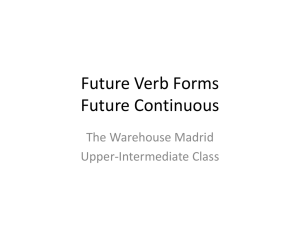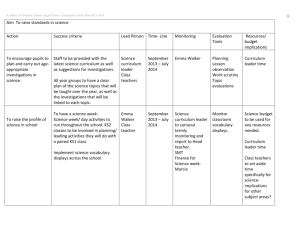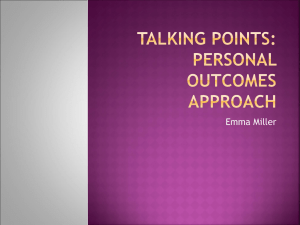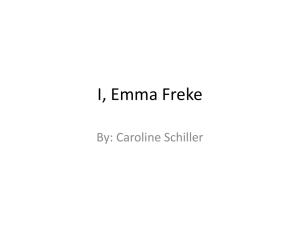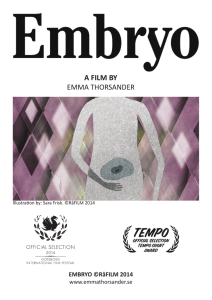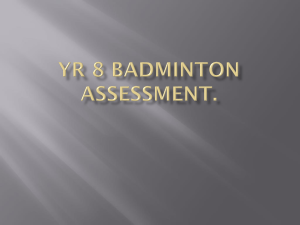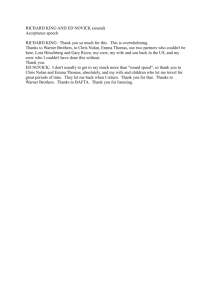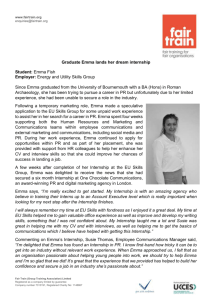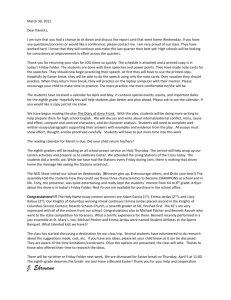Young Digital Planet 2014 – Core Curriculum for English
advertisement
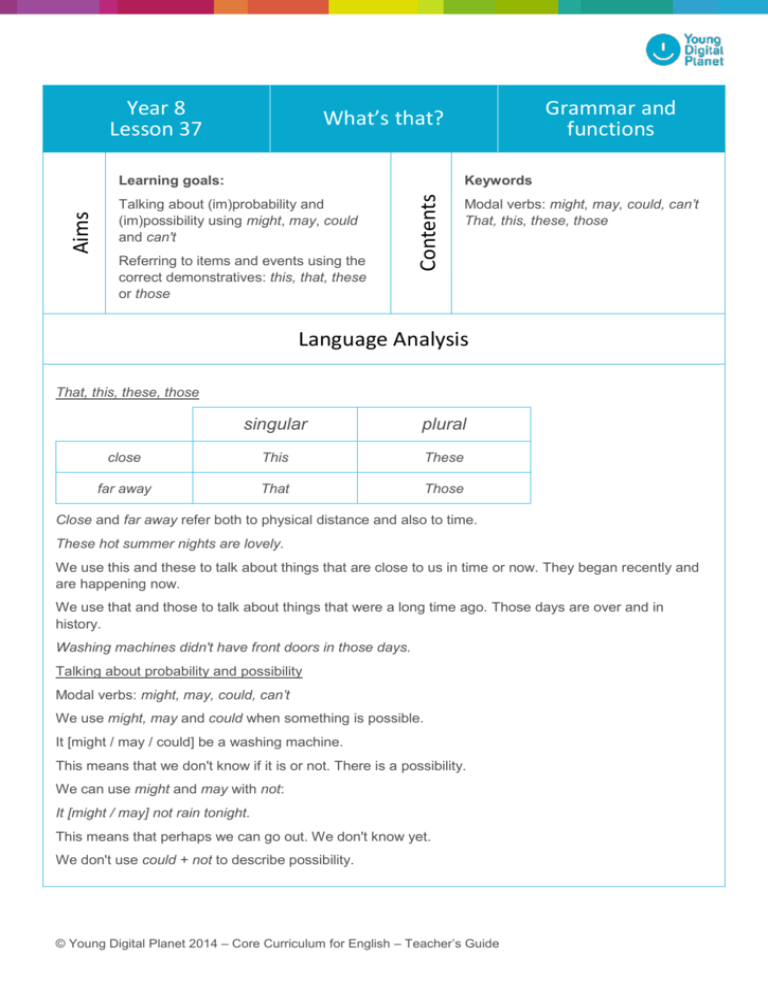
Year 8 Lesson 37 Keywords Talking about (im)probability and (im)possibility using might, may, could and can't Referring to items and events using the correct demonstratives: this, that, these or those Contents Learning goals: Aims Grammar and functions What’s that? Modal verbs: might, may, could, can’t That, this, these, those Language Analysis That, this, these, those singular plural close This These far away That Those Close and far away refer both to physical distance and also to time. These hot summer nights are lovely. We use this and these to talk about things that are close to us in time or now. They began recently and are happening now. We use that and those to talk about things that were a long time ago. Those days are over and in history. Washing machines didn't have front doors in those days. Talking about probability and possibility Modal verbs: might, may, could, can’t We use might, may and could when something is possible. It [might / may / could] be a washing machine. This means that we don't know if it is or not. There is a possibility. We can use might and may with not: It [might / may] not rain tonight. This means that perhaps we can go out. We don't know yet. We don't use could + not to describe possibility. © Young Digital Planet 2014 – Core Curriculum for English – Teacher’s Guide Everyday English: What’s this? It might be a computer. © Young Digital Planet 2014 – Core Curriculum for English – Teacher’s Guide Procedure Lead-in Audio: 1 Person A: What’s this? Person B: It might be a computer. Person B: It may be a washing machine. Person B: It could be a microwave. Person B: It is a microwave! 2 Person A: What’s this? Person B: It may be a table. Person B: It might be a chest of drawers. Person B: It could be a wardrobe. Person B: It is a chest of drawers! Play the game. Give students the following instruction: 3 Guess what is in the picture. Person A: What’s this? Person B: It could be a bed. Person B: It might be a chair. Person B: It may be a sofa. Person B: It is a sofa! Students listen to a few questions and try to guess what the object is. If they think it is the objects they can see in the picture they are supposed to click the ‘Yes’ button that is set at the bottom of the screen. Key: See audio above. Note: Teacher shouldn’t focus on the grammar at this point but just get across the idea that the students don’t know for sure what the item in the image is until the end. Extension: When the activity is finished ask students to name all the objects that were used in the game. © Young Digital Planet 2014 – Core Curriculum for English – Teacher’s Guide Main input Audio: Emma: Thanks for helping me with my project, granddad. These old photos are amazing. Emma’s granddad: I’m happy to help. That one’s interesting. It shows all the family in the kitchen. Emma: Oh yes! What’s this? Emma’ granddad: I don’t know. The photo is a bit damaged. It might be our washing machine. Emma: It can’t be a washing machine. There’s no door. Emma’s granddad: Ha! Washing machines didn’t have front doors in those days. Could you pass me those photos? Emma: Here you are. Emma’s granddad: Now, look at this photo of my father in the sitting room. What do you think this is? Emma: I don’t know. It’s really big. It could be a cupboard, I suppose. Emma’s granddad: A cupboard? Actually, it’s a radio. Emma: A radio? It’s so big! My phone has a radio on it, granddad. Emma’s Granddad: I know and a music player app. Before doing the activity ask students to describe the picture. Ask: Why do you think it is black and white? Emma: Wow! Do you have a smartphone? Ask students to listen and read then choose the correct word. Emma’s granddad: I may have, Emma. I may have. Extension: Key: Why can’t they guess what is there in the photo? Because the photo is old and damaged. radio Ask a few follow-up questions: What is this object? Radio. What other objects are mentioned? Washing machine, cupboard, smartphone. Does Emma’s grandfather have a smartphone? He may have. © Young Digital Planet 2014 – Core Curriculum for English – Teacher’s Guide Distribute the Handouts and ask students to put the sentences in the correct order by numbering them. For key – see the audio to the screen. When the activity is done and answers checked ask students to read the dialogue in pairs. © Young Digital Planet 2014 – Core Curriculum for English – Teacher’s Guide Practice 1 Key: 1. No 2. Yes 3. We don’t know. Ask students to read and choose the correct words. Teachers make clear that might, may and could can be used interchangeably to express possibility at this level but that could, alone, has no negative form. Also, ask SS why do they think that Emma’s grandfather said he may have a smartphone. He just wants to keep her guessing. © Young Digital Planet 2014 – Core Curriculum for English – Teacher’s Guide Practice 2 Audio: William: It can’t be Kate’s bag. She took hers home. It might be Emma’s. Key: 1. 2. 3. 4. 5. can’t may not might might can’t Ask students to complete the sentences using may not, can’t and might. Note: Question 4 has to be ‘might’ because otherwise the evidence (clouds) are contradicting the next sentence. There are a lot of grey clouds. It might rain soon. This would then need the next sentence to start with a contrastive word such as ‘However…’ or for there to be a conjunction such as ‘but’. Extension: Give students more sentences and ask to finish them with may / might / can. You can write the word on the board, put students in pars and ask to work for some time OR do it as a class immediately: She is not at home. She … (e.g. may be at school) There are a lot of clouds. It … (e.g. may rain) Let’s ask Tom. He … (e.g. may know) Yes I agree with you. You… (e.g. may be right) © Young Digital Planet 2014 – Core Curriculum for English – Teacher’s Guide Practice 3 Audio: Emma: How much is that pen? Emma: How much is this pen? Emma: How much are these books? Emma: How much are those books? Key: (From left to right) 1. 2. 3. 4. that this these those Ask students to complete the sentences and then listen and check. © Young Digital Planet 2014 – Core Curriculum for English – Teacher’s Guide Practice 4 Key: 1. 2. 3. 4. These that Those This Ask students to read and complete. Note: explain that Those were the days is an exclamation meaning ‘They were very enjoyable’ © Young Digital Planet 2014 – Core Curriculum for English – Teacher’s Guide Practice 5 Key: 1. 2. 3. 4. those, might that this, might these Ask students to read and choose the correct answer. © Young Digital Planet 2014 – Core Curriculum for English – Teacher’s Guide English to take away Audio: William: What’s this? Harry: It might be a car. Let’s check. William: You’re right. It’s a car. Key: Wardrobe, TV, car, fridge Ask students to work in pairs and take turns to guess. When they want to check they should click the picture to see whether they guessed correctly. © Young Digital Planet 2014 – Core Curriculum for English – Teacher’s Guide Handout I’m happy to help. That one’s interesting. It shows all the family in the kitchen. Oh yes! What’s this? Now, look at this photo of my father in the sitting room. What do you think this is? A radio? It’s so big! My phone has a radio on it, granddad. Ha! Washing machines didn’t have front doors in those days. Could you pass me those photos? I don’t know. The photo is a bit damaged. It might be our washing machine. I may have, Emma. I may have. It can’t be a washing machine. There’s no door. I don’t know. It’s really big. It could be a cupboard, I suppose. Thanks for helping me with my project, granddad. These old photos are amazing. Here you are. A cupboard? Actually, it’s a radio. I know and a music player app. Wow! Do you have a smartphone? © Young Digital Planet 2014 – Core Curriculum for English – Teacher’s Guide
